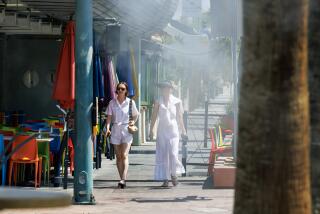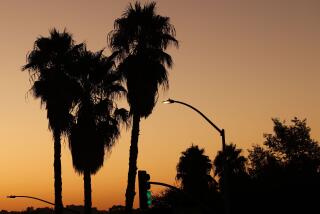Heat Marks Fall as L.A. Hits 107 : Forecasters Expect No Break for Several Days
The temperature hit a record-and-nerve-shattering 107 degrees in downtown Los Angeles on Monday and the National Weather Service said there probably will not be a break in the oppressive Southern California heat wave for several days.
As thousands managed to get to the beaches and as brush fires continued to erupt on arid hillsides, a weather service spokesman said he could not immediately tell how long it had been since the mercury reached 107 in Los Angeles. He noted that the hottest Los Angeles day on record was Sept. 1, 1955, when it was 110 at the Civic Center.
The hottest July day on the books was the 25th of the month in 1891. It was 109.
Until Monday, the hottest July 1 in Los Angeles history was in 1884, when it was an almost balmy 99 degrees. The hottest July 2 on record was in that same year, when the temperature reached 102. That mark is likely to fall today, when the downtown high is expected to be 105.
On Wednesday, said the forecasters, it should be 102.
Highs should range from 75 to 80 at the beaches and from 105 to 110 in the inland valleys. Overnight lows are expected to be in the mid-70s.
Most of California was sweltering Monday. Palm Springs had 117 and San Juan Capistrano recorded 111. Santa Ana, El Toro and Monrovia all had 110, while 108-degree readings were reported in Burbank, Montebello, San Gabriel and Woodland Hills. Long Beach, Pasadena and Riverside each had 107.
It was even hot in Northern California, where San Francisco set a new mark for the date with 99 degrees.
Forecasters said a large, strong high-pressure system in the upper atmosphere was centered over the eastern Mojave Desert, shoving hot, dry air into the Southland and pushing the marine layer out to sea. A low-pressure area may form inland by the end of the week, causing some sea breezes near the coast and cooling things off slightly in that area.
Another record was broken Monday when the minimum Los Angeles temperature did not get below 77 degrees. Until then, the highest minimum for the date was 68 degrees, set in 1960.
Relative humidity Monday ranged from 42% to 15%. With the hot, dry conditions, the fire danger remained high. The state Department of Forestry, Los Angeles city and county firefighters and the Orange County Fire Department posted “red flag alerts” signifying extreme fire danger and moved quickly to battle small blazes before they could flash out of control.
Electrical usage Monday soared as air conditioners went into action.
At 3 p.m., Southern California Edison Co. reported its peak output of 14,171 megawatts, the highest for the year and the most since June 7, when the downtown Los Angeles temperature was 94 degrees. Edison’s all-time record remained 15,189 megawatts for last Sept. 5, when the downtown high was 105.
The Los Angeles Department of Water and Power reported “a very, very dramatic” increase to 4,693 megawatts at 3 p.m. That was just 189 megawatts short of the all-time peak of 4,882 recorded on that torrid Sept. 5.
DWP spokesman Steve Hinderer said that if the heat continues today as predicted, “We will have to ask our customers to conserve as much electricity as possible between the hours of 10 a.m. and 6 p.m.”
Edison spokesman Russ Hawkes said his company would suggest the same.
In San Diego--where on Sunday heat and wind drove flames up out of a dry canyon to destroy up to 70 homes and force hundreds of people to flee--Monday’s high reading was 95, breaking a July 1 record of 85 set in 1937.
Highs could reach 120 degrees in the Palm Springs area today, the weather service said.
Beach crowds Monday were heavy--about half the size of the ones that reached the sand on Sunday. Lifeguards said about 200,000 were on South Bay beaches. Santa Monica reported another 200,000 or so and Long Beach lifeguards estimated 150,000.
First-stage smog episodes were declared by the South Coast Air Quality Management District in coastal Orange County and in the northwest coastal Los Angeles area.
More to Read
Sign up for Essential California
The most important California stories and recommendations in your inbox every morning.
You may occasionally receive promotional content from the Los Angeles Times.










